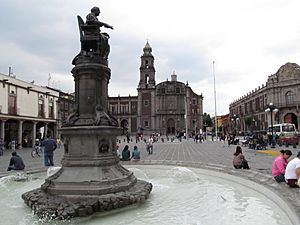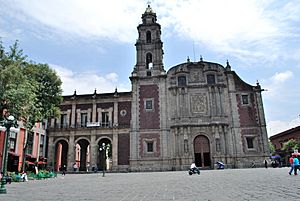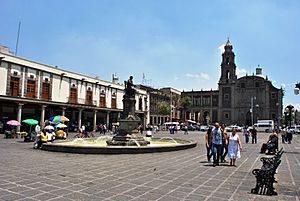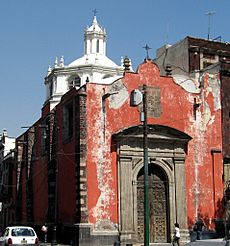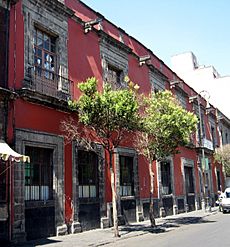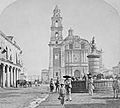Santo Domingo (Mexico City) facts for kids
Santo Domingo in Mexico City is a special place. It includes the historic Church of Santo Domingo and its lively Plaza. You can find them just three blocks north of the big Mexico City Metropolitan Cathedral. República de Brasil Street leads you there, with Belisario Dominguez Street separating the church and the plaza.
Contents
The Church of Santo Domingo
The church is officially called the Señor de la Expiración Chapel. It stands on the north side of Belisario Dominguez Street, facing the plaza. This church is all that remains of one of the very first monasteries (or friaries) built in New Spain. The Dominicans, a group of religious people, arrived in New Spain in 1526. They soon started this monastery.
They first used houses given to them by the Guerrero family. Later, the Palace of the Inquisition was built there. The Dominicans built a church, living areas, and a place for people who broke religious rules. They were in charge of religious matters at the time.
A few decades later, they needed more space. The first church on this spot was finished in 1590. A large monastery was built around it, paid for by Philip II of Spain. It had four courtyards, a main hall, a library, and a place for the sick.
However, the building was not very strong. The soft ground and earthquakes meant they had to rebuild. The second church was built between 1556 and 1571. The church you see today is the third one on this site. It is made in the beautiful Baroque style from pink stone. Its construction started in 1717 and finished in 1736. The old monastery and courtyard were destroyed in 1861 during a time when religious buildings were being removed. This created Leandro Valle Street on the west side of the church.
Church Design and Art
The church's design is thought to be by Pedro de Arrieta. It shows a Mexican Baroque style. The front of the church is covered in tezontle, a red volcanic stone. The main entrance is made of cantera, a white or grey stone.
Around the main entrance, there are twelve columns. On the first level, you can see statues of Saint Francis and Saint Augustine. On the second level, a stone carving shows Saint Dominic kneeling. He is receiving the keys to heaven from Saint Peter and religious letters from Saint Paul. The Holy Spirit is shown above them. At the very top, there is a carving of the Assumption, which is Mary going to heaven. This carving is between two windows that light the choir area inside. On the east side, there are stone figures of Saint Dominic and Saint Francis. They are shown holding up the Church of Letrán.
Inside, the church is shaped like a Latin cross. The main altarpiece is in the Neoclassical style. It was made by Manuel Tolsá to replace an older Baroque one. To the left of the transept (the arms of the cross shape), there is an altar for the Virgin of Covadonga. A large niche (a special alcove) holds an image of the Virgin Mary. Above it, there is a sculpture of the scene at Calvary. Even higher, an oil painting shows the Coronation of Mary. At the very top is the cross of the Battle of Covandonga. Two oil paintings decorate each side window, along with the coat-of-arms of Castile and the symbol of the Dominican order. The area is also decorated with carvings of saints and cherubs.
To the right of the transept, you'll find the Virgin del Camino altarpiece, made by Alonso López de Herrera. This altarpiece has figures called the "Descent" and "Saint Dominic in Soriano." It also has gilded (gold-covered) statues of the martyrs Saint Peter and Vicente Ferrer. The church also has a choir area shaped like a horseshoe. It has 32 cedar seats, each with a different saint carved into its back.
Next to the church is the Rosario Chapel, built in 1946 in a neo-Baroque style.
This church is also the resting place of Francisco Vázquez de Coronado. He was a famous conquistador and explorer. He explored a large part of what is now the southwestern United States. His expedition was one of the biggest to go into North America.
The Plaza of Santo Domingo
South of the church is Plaza San Domingo. On its west side, you'll see the Portal de Evangelistas. This is a beautiful walkway with columns and round arches. Here, you can often find scribes working with typewriters and old printing machines. These scribes help people who need documents written or advice, almost like lawyers or consultants.
In the middle of the plaza, there is a fountain with a statue of Josefa Ortiz de Dominguez. She was a brave heroine of the Mexican War of Independence. The statue was made by Enrique Alcati.
Historic Buildings Near the Plaza
A small church called San Lorenzo-Deacon and Martyr is at 28 Belisario Dominguez Street. It's to the left of the Santo Domingo Church. This small church has a long history. It is the latest in a series of chapels that have been on this spot since the 16th century. One of the oldest chapels here was called the "Chapel of the 'Morenos'." It was named this because Dominican friars taught the local people about Christianity there.
The current church used to have four altars, but now it has one simple altar. The entrance of the church is from the 19th century. It has a simple arch decorated with carved plants. Above it is a special symbol of Christ's name. This church has some serious problems with its structure. It is thought that its dome could fall at any time. Once, a large stone almost a meter wide fell, breaking pews, but luckily no one was in the church at the time.
At 97 Republica de Cuba Street, there is a house on land that once belonged to Juan Jaramillo. He was the husband of La Malinche, a famous historical figure. The house you see today was built in the 18th century, but its foundations are much older.
At 92 Republica de Cuba Street, there is a building from the time of President Porfirio Diaz (late 1800s to early 1900s). Today, this building is home to a music school.
At 37 Republica de Brasil Street, you can find the house where Leona Vicario died. She was another important heroine of the Mexican War of Independence. Today, this house is a private museum.
See also
 In Spanish: Iglesia de Santo Domingo (Ciudad de México) para niños
In Spanish: Iglesia de Santo Domingo (Ciudad de México) para niños
- List of colonial churches in Mexico City
Images for kids
-
Plaza de Santo Domingo in a painting of 1862 by Hercule Catenacci and Désiré Charnay.


